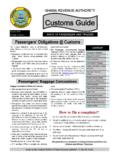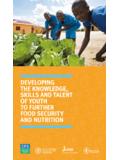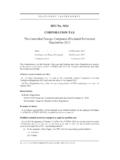Transcription of AID FOR TRADE CASE STORY - OECD.org - OECD
1 1 AID FOR TRADE CASE STORY : UK Improving Service Delivery and Reducing Clearing Times at Beitbridge Border Post Date of submission: 31st January 2011 Region: Eastern and Southern Africa Country: ESA Region Type: Programme Author: TradeMark Southern Africa Contact Details: PO Box 317, Persequor Park, Pretoria 0020, South Africa AID FOR TRADECASE STORYUK 1 Improving Service Delivery and Reducing Clearing Times at Beitbridge Border Post Table of Contents Executive Summary 1. Issues Addressed 2. Objectives Pursued 3. Design and Implementation 4. Problems Encountered 5.
2 Factors for Success/Failure 6. Results Achieved 7. Lessons Learned 8. Conclusion (applicability to other programs) Executive Summary The border post at Beitbridge is an extremely important border on the North South Corridor, with significant numbers of trucks and passenger vehicles going to and from the South African ports and, to a lesser extent, Maputo, and countries to the north such as Zimbabwe, Zambia, DR Congo and Malawi. There are also instances in which the land route to the north, into Tanzania and even into Sudan, has been used in preference to the sea route.
3 It is one border post that experiences extreme forms of traffic congestion at peak periods. Beitbridge was identified by the COMESA, EAC and SADC Tripartite as the main border post requiring serious attention to alleviate congestion, after having worked on Chirundu. Since May 2009 a number of stakeholders workshops have been convened by the COMESA-EAC-SADC Tripartite, supported by the DFID-financed TradeMark Southern Africa (and prior to this the Regional TRADE Facilitation Programme) to determine how transaction costs can be reduced through reducing clearance times and improving service delivery, leading to the design of the Beitbridge Efficiency Management System (BBEMS).
4 The objective of the BBEMS is to reduce congestion, increase operational efficiency, reduce waiting times and lower of transaction costs at the border crossing. This programme is part of a wider COMESA-EAC-SADC Tripartite work programme seeking to enhance regional economic integration through improved TRADE performance and TRADE facilitation. After further consultations between South Africa and Zimbabwe, institutional structures were established and a draft memorandum of understanding and a work programme were prepared. However, owning to a number of factors, progress in implementing the BBEMS has been extremely slow and the problems of excessing congestion, clearance delays and inefficient service delivery persist at Beitbridge border post, lowering the efficiency of the whole North-South Corridor.
5 1. Issues Addressed The Beitbridge border post, on the North South Corridor, is an extremely important border crossing between South Africa and Zimbabwe. The border crossing handles significant numbers of trucks, averaging about 470 per day and about 800 passenger vehicles per day going to and from the South African ports and, to a lesser extent, Maputo, and countries to the north such as Zimbabwe, Zambia, DR Congo and Malawi. There are also occasions 2 when the land route to the north, into Tanzania and even into Sudan, have been used in preference to the sea route. The key issues affecting traffic in both directions are: long waiting times before clearance, congestion on the border, inefficient service delivery and higher costs of transactions.
6 A situation analysis carried out in August 2009 indicated that the waiting time at the border was about 33 hours for south-bound traffic while for north bound traffic waiting time was about 45 hours. It was estimated that the cost associated with this waiting time was about US$ million for south bound and US$35 million for north bound traffic per year. These transaction costs could be greatly reduced if the border post was revamped to improve its operational efficiency and effectiveness. To improve the operational efficiency of the border crossing, TRADE facilitation measures, TRADE related infrastructure, improvements in other physical infrastructure such as roads, bridge, parking and inspection bays, offices and housing facilities, human resource capacities and information communication and technology systems needed to be addressed.
7 2. Objectives Pursued The overall objective of the BBEMS programme is to enhance regional economic integration through improved TRADE performance and TRADE facilitation along the North South Corridor. The specific objectives of the BBEMS are to: a) reduce congestion at the border crossing; b) enhance operational efficiency; c) reduce waiting times; and d) lower transaction costs at the border. 3. Design and Implementation The programme design and implementation are based on constant consultations amongst stakeholders and between the two countries and the border control agencies. The SADC Secretariat plays a co-ordination role under the programme on behalf of the COMESA-EAC-SADC Tripartite while government officials from the two countries work under an institutional framework that brings together all border control agencies and the private sector operators as follows: a) Joint Border Operations Committee: This committee is based at Beitbridge and deals with day-to-day operational issues and existed prior to the initial stakeholder meeting.
8 It was formalised by the meeting and should meet regularly and provide inputs into the Task Team. b) Task Team: The Task Team, comprising key stakeholders representing both public and private sectors, is responsible for all aspects and functions relating to the design and implementation of the Border Efficiency Management System Programme. It is tasked with the development and facilitation of the adoption of a variety of TRADE facilitation instruments aimed at improving service delivery at the border post covering customs; immigration; plant, animal and human health; food safety; security; border infrastructure and facilities; etc.
9 C) Steering Committee: The Steering Committee is responsible for policy and overall programme leadership and direction, including monitoring and evaluation. It comprises Senior Officials at the level of Director General or Permanent Secretary of Departments or Ministries or their designated representatives. 3 d) Ministerial Committee: The Ministerial Committee provides political leadership and guidance the BBEMS. The Committee is still to be formally constituted and is expected to work closely with the Ministerial Committee of the North South Corridor given the critical importance of Beitbridge to the Corridor. The institutional structure is as follows: Note: The structures inside boxes demarcated by broken borders are yet to be established.
10 The BBMES work programme, which is anchored in the COMESA-EAC-SADC Tripartite work programme, and supported by the DFID-financed TradeMark Southern Africa Programme, consists of activities which, when implemented, will result in: - Finalisation of the MoU between Zimbabwe and South Africa and its signature; - Effective and timely sharing of information among all relevant stakeholders at national and regional levels; - Development of a blueprint for an integrated standard operating procedure (SOP) manual covering procedures of all border agencies of both countries; - Adoption and implementation of common simplified and harmonised border control procedures, including carrying out joint controls by officers from both countries and the development and implementation of integrated computerised systems to enhance operational efficiency; - Improved physical infrastructure at the border post, such as roads, parking facilities, inspection bays, office space, housing, bridge, etc so as to improve operations at the border and reduce the time taken to cross the border; and - The establishment of a one stop border post.
















